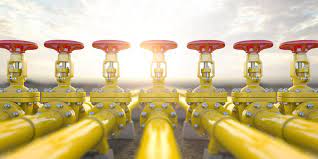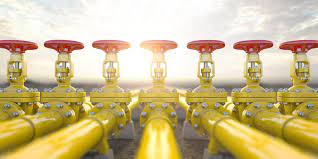
Unknown damage to the Nord Stream pipelines running beneath the Baltic Sea has dashed hopes that Russian gas flow to Germany will resume soon.
Nord Stream 1 had been shut down for maintenance since the end of August, raising concerns about supply to Europe if the outage was prolonged.
Since launching what Moscow refers to as its "special military operation" in Ukraine, it has also cut off supply to several European countries, including Bulgaria, Denmark, Finland, the Netherlands, and Poland, as well as reduced flows through other pipelines.
The options available to Europe are outlined below.
Russia typically supplies approximately 40 per cent of Europe's natural gas, primarily via pipeline. Last year, deliveries totaled around 155 billion cubic metres (bcm).
The gas is primarily routed through Ukraine to Austria, Italy, Slovakia, and other east European countries. The Ukrainian transmission system operator has declared a state of emergency at the Sokhranovka entry point pipeline, which runs through Russian-occupied territory in Ukraine's east.
However, approximately 42 million cubic metres (mcm) of gas per day is still pumped through Ukraine via the Sudzha route.
The Yamal-Europe pipeline, which connects Belarus and Poland to Germany, is one alternative route to Europe that does not go through Ukraine.
The Yamal-Europe pipeline has a capacity of 33 billion cubic meters, or roughly one-sixth of Russian gas exports to Europe. Since the beginning of the year, flows have been reversed to flow eastward between Poland and Germany, and they have been declining.
The owner of the Polish section of the Yamal-Europe pipeline has been sanctioned by Moscow. Poland, on the other hand, can manage without reverse gas flow on the Yamal pipeline, according to the country's climate minister.
Both the Nord Stream 1 and Nord Stream 2 pipelines, which were built to transport Russian gas to Europe via Germany, were damaged by blasts and will require extensive reconstruction. Because of the Ukraine conflict, Germany halted certification of the new Nord Stream 2 gas pipeline from Russia, and it never went into operation.
In October, Russian President Vladimir Putin proposed building a gas hub in Turkey as an alternative supply route, which Turkish President Tayyip Erdogan supported.
Russia has also stated that it could pump gas through a non-damaged Nord Stream 2 pipeline, but Germany has refused.
Although the global gas market was tight even before the Ukraine crisis, some countries have alternative supply options, and Europe's gas network is linked so that supplies can be shared.
Germany, Europe's largest consumer of Russian gas, can import gas via pipelines from the United Kingdom, Denmark, Norway, and the Netherlands.
Norway, Europe's second largest gas supplier after Russia, has increased output to help the European Union meet its target of eliminating reliance on Russian fossil fuels by 2027.
Centrica in the United Kingdom has agreed to a supply agreement with Equinor in Norway for the next three winters. The United Kingdom does not rely on Russian gas and can export to Europe via pipelines.
Azeri gas can be delivered to southern Europe via the Trans Adriatic Pipeline to Italy and the Trans-Anatolian Natural Gas Pipeline through Turkey.
Imports of liquefied natural gas to Europe have increased from producers such as the United States, Qatar, and others.
However, unplanned disruptions in these countries due to production capacity, incidents, and natural disasters can reduce supply.
Additionally, Europe's LNG terminals have limited capacity for additional imports, and multiple ships carrying LNG are unable to secure offloading slots. If the situation worsens, those ships may begin looking for alternative ports outside of Europe.
Several countries, including Germany, want to build new LNG terminals. It intends to construct five.
Poland, which relies on Russia for approximately 50% of its gas consumption, or approximately 10 bcm, has stated that it can obtain gas through two links with Germany.
The Baltic Pipe, which connects Norway to Poland via Denmark, began operations on October 1, though it is currently being filled with gas from Germany. It has a capacity of up to 10 billion cubic meters per year.
The opening of a Danish terminal for Norwegian gas to be pumped through the new Baltic Pipe pipeline to Poland has been pushed back to November 1 by nearly two weeks.
Poland also completed a new gas link with Slovakia in August and requested funding from the Commission in late September for a new gas pipeline connecting the Czech Republic to its network and LNG terminals.
Spain and Germany have been pushing for the construction of a new gas pipeline through the Pyrenees mountains, but France has been opposed, claiming that new LNG terminals, which can be made to float, would be a faster and less expensive option than a new pipeline.
Several nations can seek to fill any gaps in energy supplies by importing electricity from neighbors via interconnectors or increasing power generation from nuclear, renewables, hydropower, or coal.
Nuclear provision is decreasing in Belgium, the United Kingdom, France, and Germany, with plants experiencing outages as they age, are decommissioned, or are phased out. Due to low rainfall and a heatwave, hydro levels have been declining this summer.
Europe has been attempting to transition away from coal in order to meet climate targets, but some plants have been restarted in order to secure enough energy for this winter and to combat rising energy prices.
Energy ministers agreed that all EU countries should voluntarily reduce gas consumption by 15% from August to March, compared to their average annual consumption from 2017 to 2021, and set EU-wide targets for gas storage refilling.
Countries throughout Europe are also preparing for power outages, blackouts, and energy rationing. France has launched a national energy savings plan to reduce energy consumption, while the United Kingdom has warned of three-hour power outages for homes and businesses as a last resort.
The European Commission has proposed a package of emergency measures to address the energy crisis, including member states buying gas together.
(Source:www.euronews.com)
Nord Stream 1 had been shut down for maintenance since the end of August, raising concerns about supply to Europe if the outage was prolonged.
Since launching what Moscow refers to as its "special military operation" in Ukraine, it has also cut off supply to several European countries, including Bulgaria, Denmark, Finland, the Netherlands, and Poland, as well as reduced flows through other pipelines.
The options available to Europe are outlined below.
Russia typically supplies approximately 40 per cent of Europe's natural gas, primarily via pipeline. Last year, deliveries totaled around 155 billion cubic metres (bcm).
The gas is primarily routed through Ukraine to Austria, Italy, Slovakia, and other east European countries. The Ukrainian transmission system operator has declared a state of emergency at the Sokhranovka entry point pipeline, which runs through Russian-occupied territory in Ukraine's east.
However, approximately 42 million cubic metres (mcm) of gas per day is still pumped through Ukraine via the Sudzha route.
The Yamal-Europe pipeline, which connects Belarus and Poland to Germany, is one alternative route to Europe that does not go through Ukraine.
The Yamal-Europe pipeline has a capacity of 33 billion cubic meters, or roughly one-sixth of Russian gas exports to Europe. Since the beginning of the year, flows have been reversed to flow eastward between Poland and Germany, and they have been declining.
The owner of the Polish section of the Yamal-Europe pipeline has been sanctioned by Moscow. Poland, on the other hand, can manage without reverse gas flow on the Yamal pipeline, according to the country's climate minister.
Both the Nord Stream 1 and Nord Stream 2 pipelines, which were built to transport Russian gas to Europe via Germany, were damaged by blasts and will require extensive reconstruction. Because of the Ukraine conflict, Germany halted certification of the new Nord Stream 2 gas pipeline from Russia, and it never went into operation.
In October, Russian President Vladimir Putin proposed building a gas hub in Turkey as an alternative supply route, which Turkish President Tayyip Erdogan supported.
Russia has also stated that it could pump gas through a non-damaged Nord Stream 2 pipeline, but Germany has refused.
Although the global gas market was tight even before the Ukraine crisis, some countries have alternative supply options, and Europe's gas network is linked so that supplies can be shared.
Germany, Europe's largest consumer of Russian gas, can import gas via pipelines from the United Kingdom, Denmark, Norway, and the Netherlands.
Norway, Europe's second largest gas supplier after Russia, has increased output to help the European Union meet its target of eliminating reliance on Russian fossil fuels by 2027.
Centrica in the United Kingdom has agreed to a supply agreement with Equinor in Norway for the next three winters. The United Kingdom does not rely on Russian gas and can export to Europe via pipelines.
Azeri gas can be delivered to southern Europe via the Trans Adriatic Pipeline to Italy and the Trans-Anatolian Natural Gas Pipeline through Turkey.
Imports of liquefied natural gas to Europe have increased from producers such as the United States, Qatar, and others.
However, unplanned disruptions in these countries due to production capacity, incidents, and natural disasters can reduce supply.
Additionally, Europe's LNG terminals have limited capacity for additional imports, and multiple ships carrying LNG are unable to secure offloading slots. If the situation worsens, those ships may begin looking for alternative ports outside of Europe.
Several countries, including Germany, want to build new LNG terminals. It intends to construct five.
Poland, which relies on Russia for approximately 50% of its gas consumption, or approximately 10 bcm, has stated that it can obtain gas through two links with Germany.
The Baltic Pipe, which connects Norway to Poland via Denmark, began operations on October 1, though it is currently being filled with gas from Germany. It has a capacity of up to 10 billion cubic meters per year.
The opening of a Danish terminal for Norwegian gas to be pumped through the new Baltic Pipe pipeline to Poland has been pushed back to November 1 by nearly two weeks.
Poland also completed a new gas link with Slovakia in August and requested funding from the Commission in late September for a new gas pipeline connecting the Czech Republic to its network and LNG terminals.
Spain and Germany have been pushing for the construction of a new gas pipeline through the Pyrenees mountains, but France has been opposed, claiming that new LNG terminals, which can be made to float, would be a faster and less expensive option than a new pipeline.
Several nations can seek to fill any gaps in energy supplies by importing electricity from neighbors via interconnectors or increasing power generation from nuclear, renewables, hydropower, or coal.
Nuclear provision is decreasing in Belgium, the United Kingdom, France, and Germany, with plants experiencing outages as they age, are decommissioned, or are phased out. Due to low rainfall and a heatwave, hydro levels have been declining this summer.
Europe has been attempting to transition away from coal in order to meet climate targets, but some plants have been restarted in order to secure enough energy for this winter and to combat rising energy prices.
Energy ministers agreed that all EU countries should voluntarily reduce gas consumption by 15% from August to March, compared to their average annual consumption from 2017 to 2021, and set EU-wide targets for gas storage refilling.
Countries throughout Europe are also preparing for power outages, blackouts, and energy rationing. France has launched a national energy savings plan to reduce energy consumption, while the United Kingdom has warned of three-hour power outages for homes and businesses as a last resort.
The European Commission has proposed a package of emergency measures to address the energy crisis, including member states buying gas together.
(Source:www.euronews.com)














